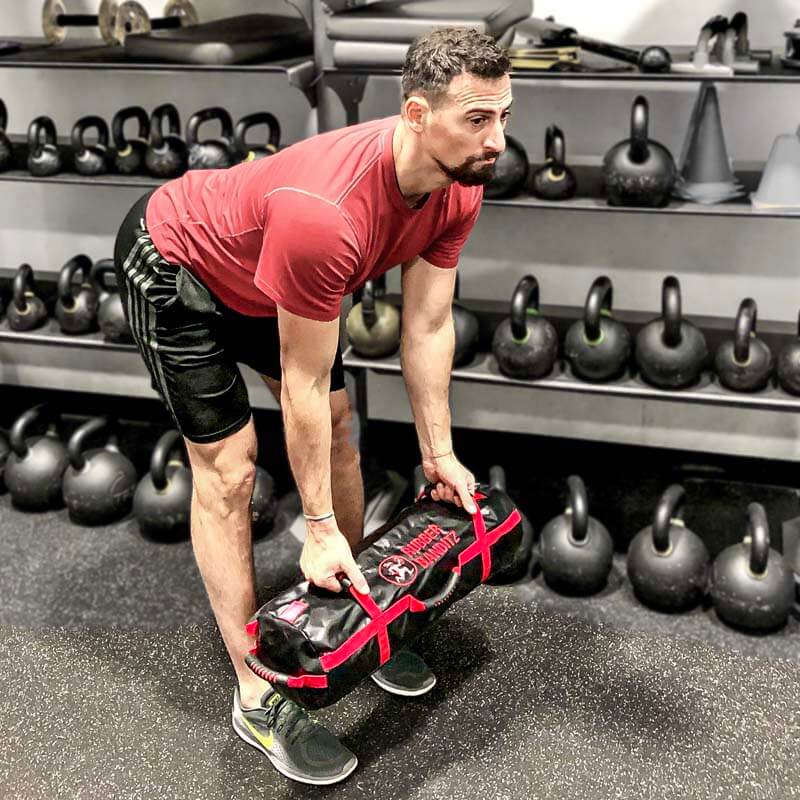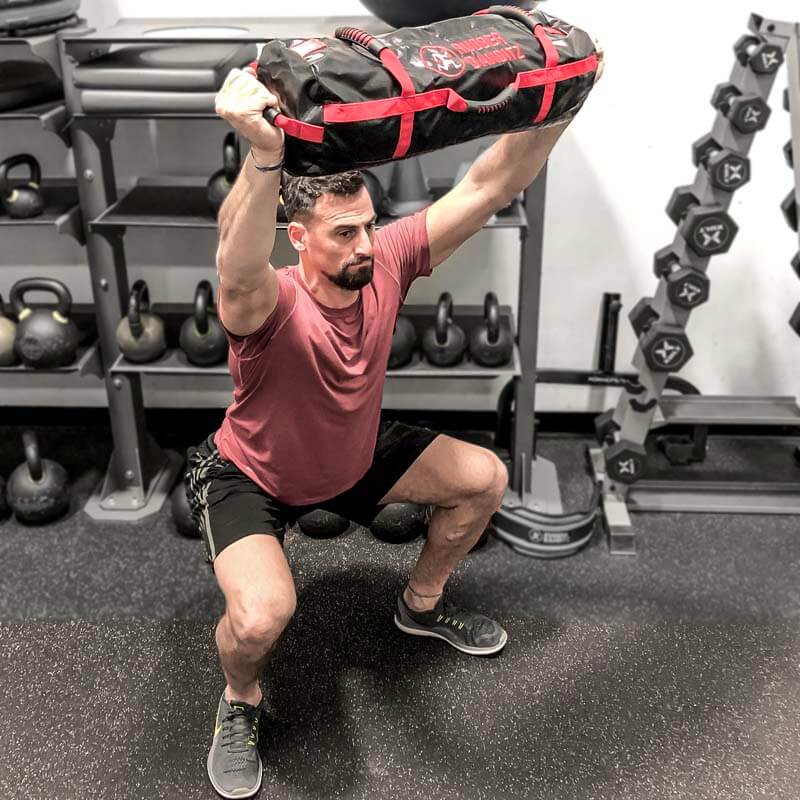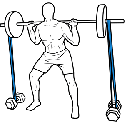Improve Your Strength, Core, and Grip With a Sandbag Workout
Looking for a new creative yet primal way to spice up your workout? Incorporating sandbag weights is a fantastic way to get a full-body workout in a fun, functional, and ferocious way.
Whether you’re bored of the same old exercise routine or want to add some functional strength, a sandbag workout is an answer. Just because you’re strong in the gym doesn’t mean you’ll be an immediate sandbag training extraordinaire. The sandbag is both a humbling equalizer and a practical training tool due to the fact that it provides unstable load, which forces your core to work more throughout your bodyweight movements.
The sandbag can be used to imitate a number of the motions we routinely perform and develop both large and small muscle groups to help prevent injury and encourage peak performance. That is partly why the sandbag is such a dynamic training tool. With one sandbag, you can get an excellent full-body workout.
When first starting out, perform sandbag training two times a week with an initial weight of around 20-40 pounds. As you become more familiar with these workouts, slowly add more weight to your routine. We commonly see intermediate to advanced men’s athlete's training with sandbags around 60-80 and 40-60 pounds for women – though this can vary widely depending on the athlete. For those individuals looking for the direct benefits of regular sandbag training, they will benefit from:
- Stronger grip – Sandbag training improves your grip strength including hands, forearms and wrists.
- Full body functional strength – with regular sandbag training, athletes will experience stronger arms, backs, shoulders and legs. Most importantly, your body learns to work in unison and so joints fire correctly.
- Core stabilization – The constant fluctuations of sandbag weights require you to focus on stabilization and provides a more surefooted foundation to improve your overall balance and proprioception.
Sandbag Weights
While you can buy a CrossFit sandbag or specially designed sandbag for your workout, there are many different options to choose from. A specialized fitness sandbag can be used, or you can even use an old duffel bag and fill it with sand to get started. Regardless of the type of sandbag weights you choose, each one of them have the following merits:
- Continuously shifting load – sandbags are awkward and are always shifting sand back and forth. This makes them challenging to balance and stabilize.
- Real-life applications – using sandbags are great for improving your strength and muscle tone. They are a great functional training accessory that models the way your body naturally performs movements.
- Builds mental strength – sandbag training is difficult and takes tremendous perseverance and determination to perform each workout, which enhances your grit while building muscle endurance.
- Trains every plane of motion – many workouts require only one or two planes of motion, but sandbags work through all three – sagittal, frontal and transverse planes.
Sandbag Exercises
Try out the sandbag training workouts listed below for a complete body training circuit. For the following exercises, it is assumed that you are working out with a sandbag with handles. If not, then simply grab the sandbag with a firm grip on both hands.
Rotating Lunge

This is an excellent leg and core workout that truly targets the glutes.
To perform the exercise, grab the sandbag with both hands so that your palms are towards each other. Stand up straight with your feet together and sandbag in front of you. Next, go step back with one foot into a good deep straight-legged lunge, flexing the front knee while feeling the glute. As you lunge back, bend over and turn the sandbag outside of the front knee. Keep your back flat.
Then return to the starting position, moving the back foot forward in line with your other foot as you bring the sandbag back to the front and stand up straight. Squeeze the glutes as you return to the position. Rapidly lunge back on the other leg, allowing the sandbag to swing outside the knee. To come back up to standing, once again move the back foot up forward and stand up straight. As you move your foot up, drive your heels into the ground and completely extend your hips each time. Remember that your back foot is more for stability so concentrate on the front lunge and loading your glute muscles.
Once you have the hang of this motion, utilize the momentum of the lunge to swing the sandbag from side to side rapidly rather than simply putting the sandbag outside of your front leg. By placing rather than swinging, novices will have much better balance and more control. The swing makes the relocation harder due to the fact that it can toss you off balance. Maintain control of the sandbag to avoid injury and over rotation.
Do 5-10 reps.
Good Mornings With Sandbag

With a front-loaded sandbag workout, you make your core work even more to support the weight. When you do it with good morning exercises, you are not just working your core, but your entire backside.
To perform the exercise, stand feet shoulder-width apart and hold the sandbag up at your chest with your arms around the bag. Then bend over while keeping your back flat. As you bend over at the waist, press your butt backward and don’t lock your knees. You will feel a stretch down your hamstrings as you concentrate on pressing your butt backwards.
Do not round your back or rock forward while bending over and relax your heels. To avoid your lower back from doing all the work, keep your back flat and core engaged. Drive through your heels while standing up and squeeze the glutes at the top of the movement. Be sure to keep the sandbag at chest level the whole time.
You can alter your position to target different muscles. To get your adductors more included, take a wider position and to specifically target the glutes and hamstrings, keep your feet closer to one another.
Do 5-10 reps.
Bear-hug Squat
If you have a hard time keeping your chest up and core tight when doing front squats, this variation might be right for you. Due to how you hold the sandbag with this squat, it makes it easier to get lower while keeping your chest up and your core engaged.
To perform the exercise, hug the sandbag in the middle, squeezing it snug towards your chest. Stand with your feet shoulder-width apart. While keeping your chest high and the sandbag tight against your chest, sit your butt backward and down. Squat as low as possible and relax the heels. Don’t let your back round forward or shrug your shoulders. Next, drive straight up, pressing down through your heels. Squeeze your glutes on top and stand up straight, hugging the sandbag tight.
Do 5-10 reps.
Sandbag Overhead Press (Alternating)

This exercise with sandbag weights is a fantastic method to work the shoulders and core.
To perform the exercise, with both hands, hold the sandbag in the middle of the bag. Put it on one shoulder with your feet hip-width apart. Push the sandbag upwards and over your head to the alternate shoulder. Slowly bring the sandbag down to the shoulder and push it back to the beginning position. Keep your core engaged so you do not feel the movement in your lower back. Also, keep your back straight throughout the motion.
If you want to make it more explosive and not just a press, you can use your legs. Start by flexing your knees a bit and return to standing as you push the sandbag upwards and over to the other shoulder. Lower it down to the other shoulder then rapidly flex your knees and utilize your legs to push the sandbag back over to the side you started. Just be sure not to make it into a full squat.
Do 5-10 reps.
Halos With Sandbag Weights
One of the most difficult exercises to perform with a sandbag, halos are a terrific way to target your core and shoulders.
To perform the exercise, hold the bag either on both sides or by the handles with your palms facing you. Stand with your feet shoulder-width apart and the sandbag hanging down directly in front of you. Pull the sandbag upwards and towards the side of your body and hip. Once there, pull the bag up and back. The movement is effectively moving the sandbag in a large circle around your head and upper body.
Pull up from one hip, to the outside of the shoulder and then move it behind your head and shoulders before bringing it back to the other shoulder and finally around front. Keep your head still as you circle and do as large of a circle as your shoulders will allow. You can utilize your hips a bit to assist you since the bag becomes harder to move while rotating, however, keep your core tight so that you do not feel it in your lower back.
Do 3-5 reps.
Conclusion
The sandbag is an incredible strength building and conditioning resource and when used properly will provide a comprehensive full-body workout. So grab a fitness sandbag and get started making deep strides on your conditioning, functional strength, and mental toughness.
We believe in you!



